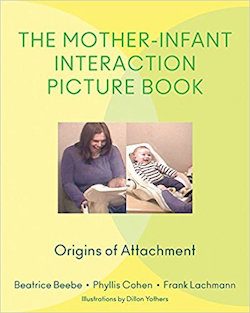Dr. Beatrice Beebe
Dr. Beatrice Beebe and her team of researchers from Columbia University have written an amazing book that looks at the powerful and life changing impacts of mother-infant interactions in the first weeks and first months of life.
Her book uses dozens of drawings done from video recordings of mother-child interactions taken at roughly 100 days old for each child, and shows how those mother-child interactions can predict — with an extremely high level of accuracy — the emotional status and the infant attachment patterns and levels that will exist at one year of life for each of the infants they studied.
That is important information to know because there already is a significant body of research that shows us that children who have attachment challenges at one year of age are much more likely to have problems in multiple areas later in life — including challenges with their school success and with their interactions with the community they are in.
Some of that research about the probability and likelihood of future problems for one-year-old children based on their interaction levels at that point in time has been around for a number of years. Being able to predict future difficulties based on early attachment levels is not new information. What we did not know until very recently, however, was that the whole process starts in very important ways, immediately after birth — and that interactions with adults in the very first weeks and months of life tend to create powerful life trajectories for children that we did not suspect, understand or anticipate.
This book helps close that particular learning gap. We now know, from the work of Dr. Beebe and her team, that we can predict with a very high level of accuracy at one hundred days what pathways children will be when they are one year old. Those first days change lives in what had been unsuspected ways and those changes need to be understood so that we can do the things we need to do to make a positive impact on the life trajectory for each child.
The brilliant work done by Dr. Beebe, Dr. Phylis Cohen, and Dr. Frank Lockmann at Columbia in assessing the status and function of mother-infant interactions in the first hundred days of life are literally illustrated in the several dozen visually powerful illustrated drawings from those interactions that are included in the pages of their new book.
The book is named — The Mother-Infant Interaction Picture Book (The Origins of Attachment).
The Columbia team filmed mother-infant interactions, analyzed their impact, and then produced an extremely innovative and useful picture book that shows and interprets those interactions for actual mothers and children.
Anyone who is concerned about the developmental future of children in this country should be aware of this research and take advantage of this book and what it literally shows us.
This book shows us that the direct interactions between infant and mother at one hundred days can be understood, tracked, and shaped in positive ways for children when we understand clearly what to influence and shape in those extremely important early time frames for each child.
The significance of what happens to children in those early time frames cannot be understated.
Life trajectories for each child begin immediately — and we now know that when children face challenges at one year of age, the results can be far reaching.
“Insecure attachment at one year is associated with less optimal peer relations and school performance (Sroufe, 1983). Insecure attachment is associated with ineffective methods of dealing with negative emotions, either maximizing and escalating negative emotions or minimizing negative emotions, with methods such as distancing, repression, and dissociation. These methods of emotion regulation generate risk for maladaptive modes of alleviating emotional discomfort (Cassidy, 1994; Dozier, Stovall-McClough, and Albus, 2008). Insecurity may reflect internal models in which the self is viewed as unable, perhaps unworthy, of getting attachment needs met from attachment figures (Bowlby, 1980; Lay, Waters, Posada, and Ridgeway, 1985). Insecure attachment poses risk for romantic relationships (Feeney, Noller and Callan, 1994;Jolland and Roisman, 2010), less optimal parenting (Haltigan, Leerkes, Supple, and Calkins, 2014; van IJz4ndoorn, 1995; Ward and Carlson, 1995), and offspring insecure attachment (Kovan, et al, 2009; Steele et al, 1996).” — [The Mother-Infant Interaction Picture Book (The Origins of Attachment) (Page 109).]
The book observes the behavior of infants with solid attachment levels, and of infants with less solid and more insecure attachment levels. It helps us understand why those levels of interactions are relevant to each child.
For example, the book identifies infants who have failed in their attempts to connect with their parent, and explains and describes what the infants with those challenges are thinking as they interact with the world.
To quote the book again — “these insecure-avoidant infants also tend to minimize other emotions, such as joy. (Cassidy, 1994) Minimizing emotions reduces the infants’ arousal level and fear (Bowlby, 1980; Cassidy, 1994). The infant’s goal is to maintain the bond with his attachment figure on whom he depends for survival (Bowlby, 1980; Main, 1981).
The book shows us in clear illustrations from the faces of both infants and their mothers what those levels and patterns of interaction between infant and parent look like in the real world. We know that we are each on a life trajectory that starts with birth and is hugely shaped by our interactions with one another from the very first days of our lives. This book shows what those trajectories actually look like for infants and mothers in the first months of life.
Now that we know how important those first interactions and initial time frames are for each child, we need to do the right things in intentional and well structured ways to help new mothers understand the ways they can interact with their children in the first weeks and months of their life.
We owe it to mothers and fathers to teach this information to every family — because it has such a huge impact on each child — and each child who does not get support in those key time frames faces an entire life of difficulty and challenge in unnecessary ways.
This book helps solidify the thinking and understanding about exactly what interactions in those first months and days are functionally important and useful in helping or disadvantaging children. Interactions clearly and obviously matter, and the right patterns of interactions can add huge value to the life of a child.
One of the truly fascinating findings from the Beebe team was that when mothers were depressed, the children were more likely to have challenges at one hundred days and at one year old — but when the depressed mothers simply interact with their children in positive ways in those initial months, despite their depression, the impact of those positive interactions with the infant can more than offset the depression of the mother, and the children who had the positive interactions with their depressed mother did not have the same negative and damaging impact as other children with depressed mothers who did not receive the positive interactions.
In other words — one very important finding from this particular set of research is that it is the interactions with the relevant adult that shape the mental mind-set of the children, and it is not the mother’s depression that determines the status in that key area for each child.
The new book also shows that when mother-infant interactions are going poorly and the child is reacting in negative ways, it seems possible to add another adult into the interactions at that point, and the child in need will switch their attention to that additional loving adult. That willingness and ability of children to seek and accept that level of interaction and support from another adult when offered tells us we can add resources to the interaction levels for children in ways they will welcome, and that will create positive outcomes for the child.
Dr. Beebe and her team refer to that ability to seek support from another caring adult as Amazing Human Resiliency.
The book is unique in several respects. Most books on topics of human behavior are entirely reliant on words, concepts, and verbal descriptions of what the authors observe and believe. This lovely book goes a major step further forward, shows us video-recording based drawings of the infant-mother interactions, and allows each of us as readers to reach our own conclusions about what we are seeing and reading.
The authors very clearly show the mother-infant communication patterns at four months old that “predicted secure as well as insecure infant attachment patterns at one year.” (Page 1)
We know from other empowering new research that the first three years of life are when the neuron connections in each child’s brain, created by adult interactions, are the most important factors in determining the learning ability levels for children.
We know the neuron strengthening process peaks for each child before four years of age — and we know the brain of each child is pruning itself of unused connections by age four. We know schools fail miserably in closing learning gaps between children at 15 years old, because the biological processes that allow those gaps to close are happening at 15 months for each child, and they are long done before the children ever get to school — much less high school.
We know that the children who are nurtured and fed in the first months of life are more likely to do better at multiple levels than the children who are not nurtured and not fed in those time frames.
The lifetime consequences of not getting the right start are huge — and our knowledge about the things we need to do to create the right start is growing daily.
To quote the book one more time about why getting the right start and creating secure attachment levels is so important to each child — “Secure attachment at one year is associated with better peer relations, school performance, and capacity to regulate emotions, as well as fewer adjustment problems in childhood and adolescence (Sroufe, 1983) Disorganized attachment is associated in childhood with oppositional, hostile-aggressive, fearful behavior, low self-esteem, and cognitive difficulties (Jacobsen, Edelstein, and Hofmann, 1984; Lyons-Ruth et all, 1999; Sroufe, 1983;).”
Disorganized attachment at 12 to 18 months predicts more serious psychological problems in childhood and young adulthood (Grossman, et al,; 2002,; Shi, Bureau, Easterbrooks, Zhao, and Lyons-Ruth, 2012, Sroufe et all, 2005 a and 2005 b).
The attachment levels for children at one year of age are so critically important that we must, as a society, recognize the importance of having solid attachments — and we need to do the right things for each child in the first months of life, when the interactions are creating or undermining that sense of attachment.
The Mother-Infant Interaction Picture Book (Origins of Attachment) by Dr. Beatrice Beebe and her team is a major gift to society, because it shows us what those interactions actually are and helps us understand both why those interactions are so important to each child.
Knowledge is power.
That particular set of knowledge gives us the power to change lives, and that wisdom and knowledge creates a level of ethical accountability for us all about the need, for each of us, to help the children being born today who are not getting the help they need, affording them the right opportunities to thrive and have better lives.
We can do so much better.
This book helps us define and understand both what ‘better’ means and what ‘better’ actually looks like.
*Please click the link below for an additional review by Norka T. Malberg, PsyD at the Yale Child Study Center and Western New England Psychoanalytic Society and Institute for Psychoanalysis, New Haven, Connecticut — DOI: http://dx.doi.org/10.1037/pap0000183


